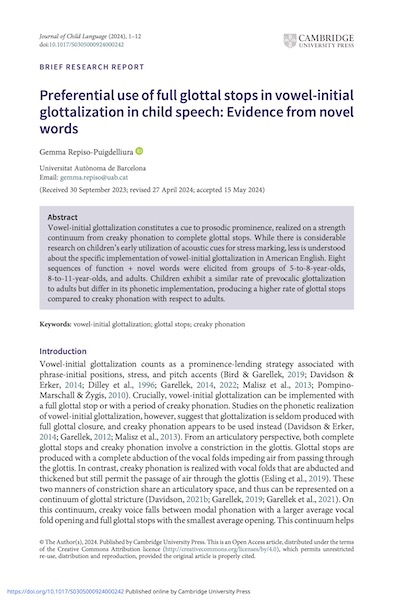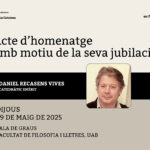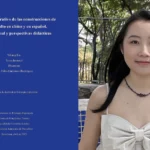3 octubre, 2024

Autors:
Gemma Repiso-Puigdelliura
Títol:
Preferential use of full glottal stops in vowel-initial glottalization in child speech: Evidence from novel wordsEditorial: Journal of Child Language (Cambridge University Press)
Data de publicació: 3 d'octubre 2024
Text completVowel-initial glottalization constitutes a cue to prosodic prominence, realized on a strength continuum from creaky phonation to complete glottal stops. While there is considerable research on children’s early utilization of acoustic cues for stress marking, less is understood about the specific implementation of vowel-initial glottalization in American English. Eight sequences of function + novel words were elicited from groups of 5-to-8-year-olds, 8-to-11-year-olds, and adults. Children exhibit a similar rate of prevocalic glottalization to adults but differ in its phonetic implementation, producing a higher rate of glottal stops compared to creaky phonation with respect to adults.
26 novembre, 2024

Autors:
Francesc Torres-Tamarit
Títol:
Proceedings of the 39th West Coast Conference on Formal LinguisticsEditorial: Cascadilla Proceedings Project, Somerville, MA, USA
Data de publicació: 2024
Més informació
Text completAccording to Loporcaro's (2015) book on Romance length, contrastive vowel length in northern Italo-Romance is metrically-governed and implicationally distributed. CVL in proparoxytones implies CVL in paroxytones, but not the other way around. Likewise, CVL in paroxytones implies CVL in oxytones, but not vice versa. This paper develops a foot-based OT analysis of CVL in northern Italo-Romance that combines layered feet (Martínez-Paricio & Kager 2015) with uneven trochees (Jacobs 2019). The analysis adequately predicts the implicational distribution of CVL and discards unattested patterns.
21 gener, 2025

Autors:
Daniel Recasens & Fernando Sánchez‑Miret
Títol:
An Acoustic Analysis of VowelsEditorial: Languages, MDPI
Data de publicació: 2025
Pàgines: 19 Més informació
Text completThe present study is concerned with some aspects of the production of [ɨ] and [ə] in Romanian, i.e., their position within the vowel space, degree of acoustic variability and acoustic duration. To this end, acoustic data were collected for the Romanian stressed vowels [i e a o u ɨ ə] produced by six speakers in controlled consonantal context conditions and real and nonsense words. The formant frequency data reveal that [ɨ] and [ə] do not overlap along the F1 dimension, which may be ascribed to the need to set in contrast the two central vowels phonologically. Moreover, [ɨ] is clearly more variable in F2, and thus in vowel fronting, than schwa. Regarding segmental duration, [ɨ] is as short as high vowels and shorter than schwa, whose duration is comparable to that of mid vowels. The phonetic characteristics for stressed schwa in Romanian are in contrast with those for the same vowel in other world’s languages, in which it is highly variable and shorter than all or most peripheral vowels. This behaviour may be attributed to the existence of two central vowels, while suggesting that [ə] has a well-defined articulatory target in the Romanian language.
20 gener, 2025

Autors:
Lourdes Aguilar, Juana Gil Fernández (coord.) & Joaquim Llisterri (coord.).
Títol:
Fonética i fonología descriptivas de la lengua españolaEditorial: Georgetown University Press
Data de publicació: 2024
Més informacióLa descripción más actualizada y completa del sistema fonético y fonológico de la lengua española.
Aunque se ha investigado mucho sobre fonética y fonología del español, hasta ahora no existía ninguna obra de referencia descriptiva exhaustiva y completa. Fonética y fonología descriptivas de la lengua española Volúmenes 1 y 2 es una obra de referencia exhaustiva, escrita en español, que describe la fonética y la fonología del español. Editado por Juana Gil Fernández y Joaquim Llisterri, este conjunto ofrece una visión de conjunto para comprender los temas segmentales y suprasegmentales de la fonología española, dejando claro lo que hace falta seguir investigando.
El conjunto internacional de colaboradores de esta referencia esencial presenta pruebas nunca antes analizadas, introduce nuevos conceptos teóricos y cuestiones no consideradas anteriormente, amplía el alcance de los estudios de casos y organiza sus numerosos subtemas, además de sugerir nuevos temas para futuras investigaciones. Este libro, una referencia descriptiva con abundantes figuras y tablas, es la clave de los supuestos del campo y una presentación de la investigación aceptada en la que se basan los futuros estudios. Con información de vanguardia sobre todos los temas relacionados con los sonidos del español, Fonética y fonología descriptivas de la lengua española será un valioso recurso para investigadores, estudiantes y estudiosos de la lingüística española que deseen profundizar en el conocimiento de las características fonéticas y fonológicas de todas las variedades de la lengua española.
5 febrer, 2025

Autors:
Real, Espinal & Villalba
Títol:
Vaya in Spanish. From a judgment to a commitment markerEditorial: Journal of Historical Syntax
Data de publicació: 05-02-2025
Pàgines: 26 Més informació
Text completIn this paper we show the diachronic development of Spanish vaya, which goes from a form of the motion verb ir ‘to go’ to an epistemic verbal discourse marker (VDM) associated with the speaker's judgment regarding a proposition (e.g. ¡Vaya! ‘Wow!’ or ¡Vaya que es donoso! ‘How funny you are!’), and then to a VERUM marker (Leonetti & Escandell-Vidal 2009, Gutzmann, Hartmann & Matthewson 2017) encoding the speaker's strong commitment to the truth of a proposition (e.g ¡Vaya si se casa! ‘You bet he's getting married!’). We argue that this shift is a clear case of a run-of-the-mill process of grammaticalization involving three stages and each change corresponds to a different position of vaya in the articulated Speech Act layer advocated by Manfred Krifka (2021). When vaya expresses a subjective epistemic attitude of the speaker, it is postulated in J(udgement)P(hrase), a position associated with epistemicity and evidentiality; when vaya expresses a strong commitment of the speaker to the truth of the proposition it precedes (i.e., a VERUM marker), it is postulated in the higher Com(mitment)P(hrase). All in all, this study argues that the grammaticalization path of vaya is not only unidirectional (against previous analysis like Octavio de Toledo y Huerta 2001 and Company Company 2008), but rather obligatorily implies a bottom-up reanalysis (Roberts & Roussou 2003).









